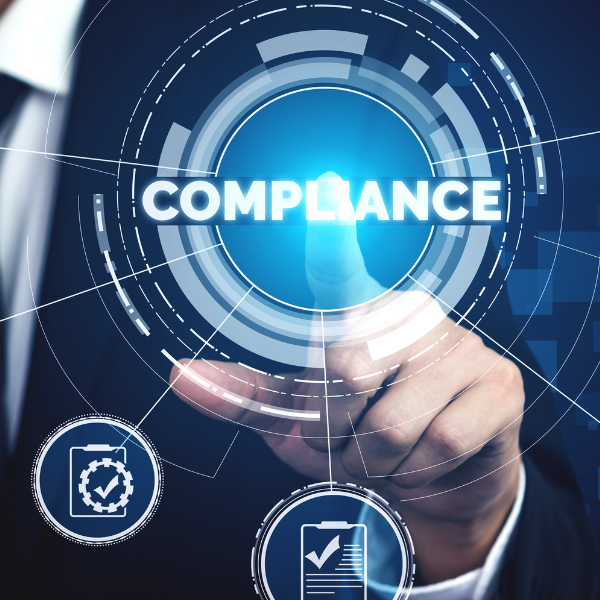
Every business, from global corporations to small businesses, faces increasing cybersecurity risks, tougher privacy regulations, and expanding compliance duties. The stakes are higher than ever, with a single data breach resulting in significant financial losses, substantial legal penalties, and lasting reputational damage.
Cyber compliance is essential for reducing these threats. It ensures that your company adheres to the rules, regulations, and frameworks designed to safeguard sensitive data and maintain trust.
Aside from avoiding penalties, cyber compliance promotes a proactive security culture, increases resilience, and instils trust in clients and stakeholders.
What Is Cyber Compliance?
Cyber compliance refers to the adherence to laws, standards, and best practices that regulate how organizations protect, store, and manage digital information. These frameworks define the technical and procedural controls businesses must implement to ensure data privacy, integrity, and availability.
Compliance requirements vary by industry and geography, but they all share a common goal: to protect sensitive information from unauthorized access, theft, or misuse.
A reliable Compliance Management System (CMS) helps organizations manage these requirements systematically, ensuring that policies, audits, and controls are consistently maintained.
Key Cybersecurity Regulations and Standards
Numerous frameworks influence the world of business cybersecurity compliance, each with a focus on certain data kinds, sectors, or locations.
Understanding these regulations is necessary for any company that wants to retain compliance and trust.
1. General Data Protection Regulation (GDPR)
GDPR is one of the world’s most comprehensive data protection rules, and it is enforced throughout the European Union. It requires enterprises to get express consent before processing personal data, alert authorities of data breaches within 72 hours, and protect individuals’ rights to view and erase their data.
2. Health Insurance Portability and Accountability Act (HIPAA)
HIPAA regulates how healthcare providers, insurers, and their partners manage patient health information. Compliance requires that Protected Health Information (PHI) be securely kept, transmitted, and accessed only by authorized persons.
3. Payment Card Industry Data Security Standard (PCI DSS)
PCI DSS is a global standard that applies to any organization handling credit or debit card transactions. It outlines strict security measures, including encryption, access control, and regular system monitoring.
4. SOC 2 (Service Organization Control 2)
This standard evaluates how cloud-based and service providers manage customer data, emphasizing principles like security, confidentiality, and privacy.
5. NIST Cybersecurity Framework (CSF)
Developed by the U.S. National Institute of Standards and Technology, the NIST CSF provides a flexible set of best practices and guidelines for managing and reducing cybersecurity risk.
Benefits of Maintaining Strong Cyber Compliance
Maintaining strong Benefits of cyber compliance is a strategic advantage and organizations that prioritize compliance enjoy several benefits:
- Enhanced Data Security: Compliance mandates stricter access controls, encryption, and monitoring, strengthening overall data protection.
- Customer Trust and Loyalty: Demonstrating compliance reassures clients that their data is safe, boosting brand reputation and retention.
- Legal and Regulatory Protection: Meeting standards shields organizations from heavy penalties and legal liabilities.
- Operational Efficiency: Implementing structured compliance frameworks improves internal processes, accountability, and risk management.
- Business Growth Opportunities: Many government contracts, investors, and enterprise clients require proof of compliance before engagement.
- Incident Preparedness: Compliance-driven organizations have incident response and recovery plans in place, minimizing downtime after attacks.
Role of Employees in Ensuring Cyber Compliance
Even the most advanced cybersecurity technologies can fail if employees are not vigilant. Human error remains a leading cause of compliance breaches, making staff awareness and training essential.
Employees play critical roles in:
- Following Security Policies: Adhering to data handling and password protocols.
- Recognizing Threats: Identifying phishing attempts, social engineering tactics, and suspicious activities.
- Reporting Incidents: Quickly escalating issues to the IT or compliance department.
- Protecting Endpoints: Using secure networks, keeping devices updated, and avoiding unauthorized software.
How Technology Helps in Meeting Compliance Requirements
Modern technology simplifies compliance management by automating processes, reducing errors, and ensuring continuous oversight.
By integrating these technologies into your Compliance Management System, you can streamline compliance workflows and maintain readiness for audits.
Some essential tools include:
- Compliance Management Software: Centralizes documentation, reporting, and risk tracking.
- Data Encryption Tools: Protect sensitive information during transmission and storage.
- Access Management Systems: Enforce user authentication and least-privilege policies.
- Security Information and Event Management (SIEM): Provides real-time monitoring and incident response.
- Cloud Compliance Platforms: Offer built-in security and compliance features for hybrid and remote environments.
Future Trends in Cyber Compliance and Regulatory Changes
The context of cyber compliance is continuously changing, driven by fast technical breakthroughs, increasingly complex cyber threats, and growing worldwide concern about data protection.
Governments and regulatory organizations throughout the world are reacting with increasingly comprehensive, adaptive, and technology-driven compliance standards.
1. AI-Driven Compliance Tools
Artificial intelligence (AI) and machine learning (ML) are altering the way businesses handle compliance. Traditional compliance monitoring frequently entails manual audits, static reporting, and human oversight. This can be time-consuming and prone to mistakes.
AI-powered compliance technologies are now automating these tasks. They may continually scan systems for deviations from compliance baselines and identify abnormalities or policy breaches in real time.
2. Rise of the Zero Trust Framework
The conventional “castle-and-moat” approach to cybersecurity, in which internal users are trusted by default, is no longer enough in an age of remote labor, hybrid networks, and sophisticated intrusions. The Zero Trust concept is based on a simple yet powerful principle: “Never trust, always verify.” Each person and device must be verified and approved before accessing data. Access privileges are provided based on context rather than assumptions.
3. Privacy-Enhancing Technologies (PETs)
As data collection and sharing grow increasingly common, Privacy Enhancing Technologies (PETs) are emerging as vital tools for complying with stringent privacy regulations such as GDPR, CCPA, and future global equivalents.
4. Global Data Protection Convergence
The global compliance landscape is becoming more unified, as countries draw inspiration from leading frameworks like GDPR. Nations are establishing laws that align closely with GDPR principles such as transparency, accountability, and data subject rights.
This global convergence is a double-edged sword. On one hand, it simplifies compliance for multinational organizations by creating consistent standards. On the other hand, it raises the bar globally, requiring even small enterprises that serve international clients to meet higher privacy expectations.
Conclusively, the importance of cyber compliance cannot be overstated. It is the foundation upon which business security, reputation, and trust are built.
CyberShield CSC is your trusted partner in navigating the complex world of cybersecurity compliance. We help you protect your data, your reputation, and your business’s future.
Frequently Asked Questions
1. What is the main goal of cyber compliance?
The primary goal is to protect sensitive data and ensure organizations follow legal, ethical, and technical standards for information security.
2. How does cyber compliance differ from cybersecurity?
Cybersecurity focuses on protecting systems from threats, while cyber compliance ensures adherence to regulations governing that protection.
3. Which are the 10 compliance standards businesses should know?
Key ones include GDPR, HIPAA, PCI DSS, ISO 27001, SOC 2, NIST CSF, CCPA, FISMA, GLBA, and FERPA.
4. What industries need cyber compliance the most?
Sectors that demand the highest compliance needs include healthcare, finance, retail, government, and technology.





